This Week's Show
Air Date: September 26, 2025
FULL SHOW
SEGMENTS
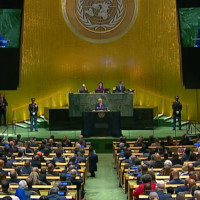
Trump Denies, China Leads on Climate
/ Aynsley O’Neill and Jenni DoeringView the page for this story
Speaking at the United Nations General Assembly, President Trump railed against climate science and clean energy, drawing sharp rebukes from other nations, rival politicians and business leaders. Meanwhile, China for the first time ever announced a specific target for reducing its greenhouse gas emissions, by 7 to 10 percent by 2035. Hosts Aynsley O’Neill and Jenni Doering talk about the diverging rhetoric and action on climate. (06:59)
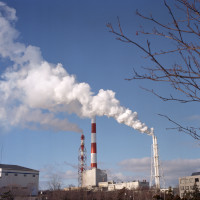
The EPA Wants to Ignore GHG Emissions
View the page for this story
The Environmental Protection Agency has proposed ending the Greenhouse Gas Reporting Program, which requires the biggest industrial facilities and power plants in the country to report their global warming emissions. David Cash, former EPA Administrator for Region One – New England, joins Host Aynsley O’Neill to discuss the potential consequences of this Trump Administration decision. (07:47)
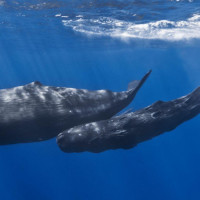
Note on Emerging Science: Whales Mistake Plastic for Food
/ Don LymanView the page for this story
Deep-diving whales use echolocation to hunt in the pitch black of the deep ocean. Research shows that plastic debris in the ocean “looks” very similar to common whale prey, like squid, when hit with these sound waves. Living on Earth’s Don Lyman reports that whales may be mistaking this plastic debris for their food. (02:03)
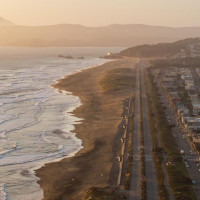
Highway Reborn as Public Park
View the page for this story
The four-lane Great Highway used to run along the Pacific Ocean on the west side of San Francisco, where it was at risk of flooding from sea level rise. Now it’s been transformed into a park where visitors can bike, walk, skate, and play next to the water. Zach Lipton, a volunteer with the nonprofit Friends of Sunset Dunes, speaks with Host Jenni Doering about this highway’s transformation. (13:07)
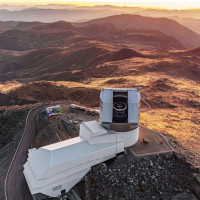
An Extraordinary New Telescope
View the page for this story
The new Vera C. Rubin observatory telescope in Chile features the largest camera ever built, at about the size of a small car, and will soon begin photographing the entire southern sky repeatedly for a full decade. Clare Higgs, an astronomer on the Rubin Education and Public Outreach team, joins Host Aynsley O’Neill to share how this new telescope can help advance our understanding of dark matter, reveal hard-to find interstellar objects, and much more. (16:19)
Show Credits and Funders
Show Transcript
250926 Transcript
HOSTS: Jenni Doering, Aynsley O’Neill
GUESTS: David Cash, Clare Higgs, Zach Lipton
REPORTERS: Don Lyman
[THEME]
DOERING: From PRX – this is Living on Earth.
[THEME]
DOERING: I’m Jenni Doering
O’NEILL: And I’m Aynsley O’Neill.
President Trump denies climate change at the UN.
TRUMP: All of these predictions made by the United Nations and many others, often for bad reasons, were wrong. They were made by stupid people that have cost their countries’ fortunes and given those same countries no chance for success. If you don't get away from this green scam, your country is going to fail.
DOERING: Also, what makes a San Francisco park so unique.
LIPTON: It used to be a four-lane highway and has been converted into a recreational space for people to walk and bike and sit by the ocean, have a bite to eat and just enjoy our Pacific coast.
DOERING: We’ll have those stories and more, this week on Living on Earth. Stick around!
[NEWSBREAK MUSIC: Boards Of Canada “Zoetrope” from “In A Beautiful Place Out In The Country” (Warp Records 2000)]
[THEME]
Trump Denies, China Leads on Climate
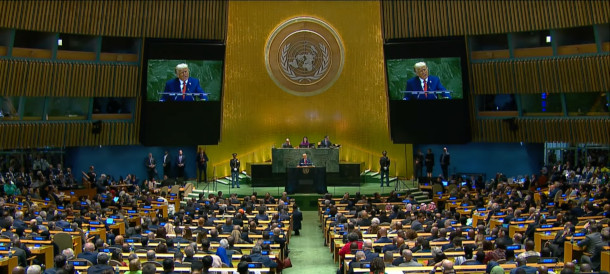
During his address to the United Nations General Assembly, President Trump railed against climate action and renewable energy. (Photo: Screenshot from White House video)
O’NEILL: From PRX and the Jennifer and Ted Stanley Studios at the University of Massachusetts, Boston, this is Living on Earth. I’m Aynsley O’Neill.
DOERING: And I’m Jenni Doering.
So, as you know Aynsley, some of the world’s most powerful people gathered in New York City in recent days for the annual opening session of the United Nations General Assembly.
O’NEILL: Yeah, and that always coincides with Climate Week NYC, when business leaders and politicians take the stage to talk up green energy and sustainability.
DOERING: Exactly, so climate is often at top of mind as these world leaders gather at the UN, and there’s a fair amount of scrutiny on global climate action. But in his speech to the UN General Assembly on September 23rd, President Trump railed against the very notion that the climate might be in trouble.
TRUMP: It's the greatest con job ever perpetrated on the world, in my opinion. Climate change, no matter what happens, you're involved in that. No more global warming, no more global cooling. All of these predictions made by the United Nations and many others, often for bad reasons, were wrong. They were made by stupid people that have cost their countries’ fortunes and given those same countries no chance for success. If you don't get away from this green scam, your country is going to fail.
O’NEILL. Wow, those are some pretty harsh words on clean energy and climate action, even from President Trump, who’s been calling climate change a hoax for a decade or so. And just for the record, there is broad and overwhelming scientific consensus that the Earth has been heating up because of the massive amounts of greenhouse gases humanity has pumped into the atmosphere since the industrial revolution.
DOERING: Yeah, I don’t need to tell you the evidence is overwhelming at this point. The last 10 years were the ten hottest on record. And 2024 tops the list with a departure from the pre-industrial average of 1.5 degrees Celsius, that’s according to the World Meteorological Organization.
O’NEILL: Sadly, Jenni, I don’t think these sobering numbers are really all that surprising, are they?
DOERING: No, they shouldn’t be, since scientists with the Intergovernmental Panel on Climate Change or IPCC have been studying this for decades, and you know, their predictions have actually been pretty darn prescient. Inside Climate News pointed to a Tulane University-led study published last month that showed the IPCC had accurately projected the actual sea level rise that’s happened since its 1995 assessment, within just 1 centimeter.
O’NEILL: Sounds like they were spot on. And, Jenni, I heard that in his speech, the President once again made a point of trashing renewable energy, what did he say there?
DOERING: Yeah, his words there would not have been surprising to anyone watching his administration’s campaign against solar and wind turbines.
TRUMP: They’re a joke, they don’t work. They’re too expensive, they’re not strong enough to fire up the plants that you need to make your country great. The wind doesn’t blow, those big windmills are so pathetic and so bad, so expensive to operate.
Donald Trump’s climate denial is an abomination and a disgrace.
— Governor Gavin Newsom (@CAgovernor) September 24, 2025
History is watching, and future generations are counting on us to act. pic.twitter.com/SybEnlKJ6G
O’NEILL: Okay – but I thought those renewables are now considered very affordable.
DOERING: They really are, um, wind and solar photovoltaics are now the cheapest forms of energy on the planet according to the International Energy Agency. Speaking during climate week NYC, leaders pushed back on President Trump’s claims, including California Governor Gavin Newsom who reminded the audience of the very high stakes.
NEWSOM: What an abomination, what an embarrassment –
[APPLAUSE]
-- what a fraud. And I say that as a guy that lives in one of the most crisis-prone states in America. But a state that’s seen lifestyles, places, traditions completely destroyed because of the reality of climate change. I’ve seen communities like Grizzly Flats and Paradise, California wiped off the map. There’s no Republican – we’ve said this many times -- or Democratic thermometer, it’s just reality. And a lot of us are getting mugged by reality. Wake up – wake up to the reality.
O’NEILL: “Mugged by reality” – that’s a memorable phrase.
DOERING: Yeah, that’s gonna stick with me too.
O’NEILL: And did other world leaders who spoke at Climate Week indicate that they’ve woken up to reality?

Xi Jinping, General Secretary of the Chinese Communist Party and President of China. (Photo: Juan Diego Cano, Wikimedia Commons, public domain)
DOERING: Absolutely, and for the first time in more than 30 years of the climate treaty China announced a specific target for reducing its greenhouse gas emissions. China pledges to cut emissions by 7 to 10% by 2035 which puts it ahead of the United States, which under Trump is making no commitments to address the climate emergency. You know, Aynsley, the Chinese pledge is modest compared to the European Union, which is expected to pledge a more than 66 percent reduction. Still, experts including the Center for Research on Energy and Clean Air suggest China can achieve a 30 percent reduction by 2035. For now though it seems unwilling to be locked into this more ambitious target that would help put serious brakes on the rising rate of climate disruption.
O’NEILL: Okay. But Jenni, what else have you seen in reaction to the President’s attacks on climate action and clean energy?
DOERING: Well, at Climate Week NYC, business leaders also spoke out. Andrew Forrest is the executive chairman of the mining company Fortescue, which recently canceled plans to build a $210 million EV battery factory in Michigan after the Republican repeal of clean energy tax credits.
FORREST: I feel real pain when I hear your president saying global warming is a great big con. Well, fellow businessman, I happen to own several million acres of land in Australia. Come and see what’s happening to my land. Come and dive on these reefs, which were the most beautiful environments on Earth and are now devastated, covered in moss. There’s real damage being done to people’s lives all over the world by your president propagating a complete myth that global warming isn’t happening.
DOERING: And you know this billionaire businessman came right out and said our societal obsession with economic growth is totally misguided.
FORREST: I can’t tell you how irrelevant that is in the fullness of anthropogenic time. You know, you are a blip in time. What matters way more in all of time, of humanity, organic time, is are we going to screw this climate or not?
DOERING: And to me that kind of long view is humbling in a good way.
O’NEILL: Yeah, I know what you mean – I think it reminds us we just happen to be the most powerful species on this planet, at the moment, and maybe we should try to be better caretakers of it. And a little more humility about how we live on this Earth would probably serve all of us well.
DOERING: Especially our leaders.
Related links:
- The White House video of President Trump’s full United Nations speech
- PBS | “Trump Called Climate Change a ‘Con Job’ at the United Nations. Here Are the Facts and Context”
- reccessary | "UN Climate Summit: China pledges 10% emission cut, EU delays on climate goal"
[MUSIC: Time For Three, featuring Jake Shimabukuro, “Happy Day” on Time For Three, by N.Kendall/arr.Rob Moose]
The EPA Wants to Ignore GHG Emissions
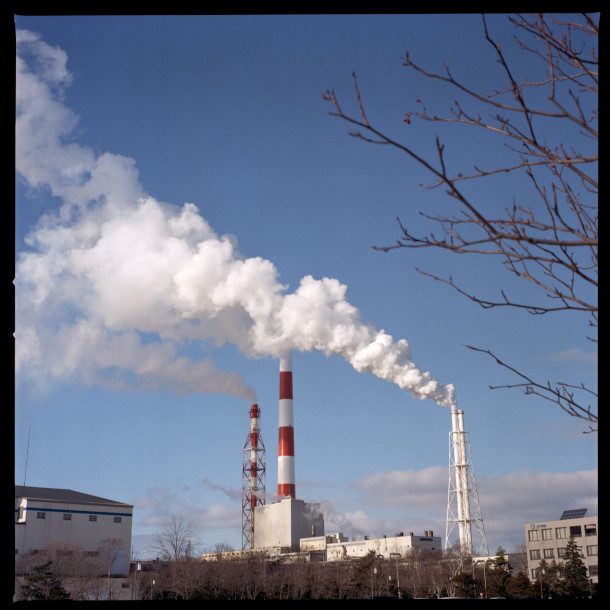
Unchecked greenhouse gas emissions warm the planet. (Photo: ejstanz, Wikimedia Common, CC BY-SA 2.0)
O’NEILL: One of the ways the Trump administration is walking back climate policy is by attempting to cancel the Greenhouse Gas Reporting Program. David Cash is the former EPA Administrator for Region One New England and he’s here to tell us more. David, welcome back to the show!
CASH: Thanks. It's good to be here.
O'NEILL: So please describe for us the purpose of this reporting program. How does it work?
CASH: So when the reporting program was put in place about 15 years ago, it was a time where the United States was moving to start regulating greenhouse gasses, because all of the science was showing that climate change caused by fossil fuel emissions of greenhouse gasses caused a whole range of problems, everything from wildfires to sea level rise to coastal flooding to river flooding, and then all the kind of health problems that would come with that, you know, hot days in the city where asthma rates spike, for example. So of course, if you're needing to regulate something like a pollutant, you have to know how much of it there is. You have to know who's emitting it and when. And for that reason, the greenhouse gas reporting program was launched by EPA, and basically it requires about 8000 of the coal burning plants, natural gas plants, manufacturing facilities that use coal or gas or oil to report what their emissions are. And that way, EPA can track them. The states can track them. Their companies can track them so they can figure out how to be better corporate citizens and reduce their emissions. So that's how that got launched 15 years ago.
O'NEILL: So over these last 15 years, to what extent has the program been successful at creating this transparency in the industry?
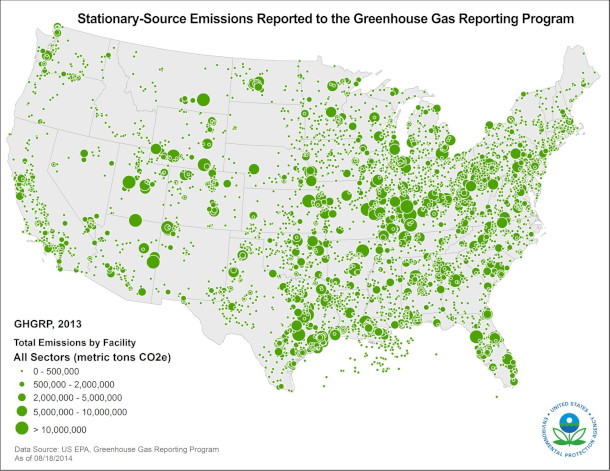
The Greenhouse Gas Reporting Program has been responsible for emissions tracking across the country for over a decade. (Photo: USEPA)
CASH: It's been quite successful, we've been able to track who's emitting what amount of greenhouse gasses, and so as EPA and states have developed programs to limit the emissions, to protect human health and the environment, the reporting program has been the backbone of that. And if I could kind of take a step back and just think if there's any action that you want to take. Let's say you're a government or let's say you're just like in a household where you see a potential problem in your house, you're going to want to know what's happening. You're going to want to figure out, you know, if you have a leak in your roof, you're going to want to know, like, how much is it leaking? When does it leak? And if you can't measure that, then there's no way that you can protect from the damage that it might be caused by that. So it's a fundamental piece that monitoring and tracking things like emissions of pollutants is critically important to understanding how they happen, and more important to understand how you can stop them from hurting human health and the environment.
O'NEILL: And how do you think policymakers would respond to the end of this program? You know, what shape might greenhouse gas policy take if we continue down this path?
CASH: Well, it's clearly going to be harder to regulate them, and that's been a very outspoken goal of this administration as it's rolling back regulations and reducing grants that go for greenhouse gas reductions and the related, you know, particulates and local air pollution and things like that.
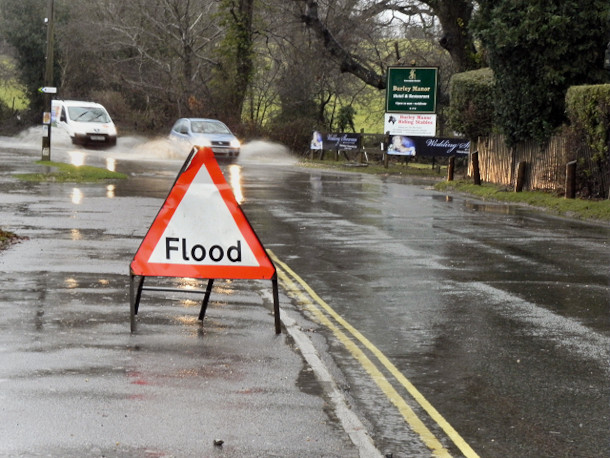
With the warming climate, the intensity and frequency of floods will only become more common. (Photo: David Dixon, Wikimedia Commons, CC BY-SA 2.0)
O'NEILL: And I can't help but also think about this in terms of record keeping and science, just generally speaking, it seems to me like this could create a data gap, which would prove difficult for future administrations.
CASH: Yeah, I think that's absolutely true, and not just future administrations, but states. There's some states that rely on the federal reporting. So some states have, and have historically, so I believe Massachusetts was one of the first states before the federal government that required greenhouse gas reporting, and that can be continued as well. And there'll be some states that will have that backstop, and others that don't, and so they're not going to be able to get the data that they need to make wise decisions in their states.
O'NEILL: And now I think I'm seeing that even with the elimination of the greenhouse gas reporting program, some fossil fuel facilities would still be required to disclose their emissions. Right? So what determines which facilities must report and which facilities are exempt?
CASH: Yeah, so there are some facilities, like natural gas pipelines, that are exempt from this reporting elimination, and that's because they were specifically identified in the Inflation Reduction Act. So are covered under a specific law that says they have to report.
O'NEILL: And now, David, how likely is it, do you think that we'll see pushback against this in the courts?
CASH: There's definitely going to be pushback as we see the administration pulling back from the reporting requirements and loosening up regulations we already are and you know, we're seeing that not just from your typical environmental group. Our national environmental groups, but we're seeing it from states. We know that attorneys general have filed lawsuits that are pushing back on the revoking of a variety of these kinds of regulations. And there are folks in the regulated community that like the certainty that comes along with the kind of reporting so that they know where they stand. They know where their competition stands. It's all part of the role that government plays of providing a level playing field in the sectors that emit greenhouse gasses.

David Cash is a former EPA Administrator for Region One New England. (Photo: David Cash)
O'NEILL: Now, David, last time we spoke to you, the Trump administration had put a stop work order on an offshore wind project called Revolution Wind. But more recently, a US District Court Judge for DC, Judge Royce Lamberth, has granted a preliminary injunction and allowed the project to resume work. What do you make of that?
CASH: This is good news. This is good news because Revolution Wind had followed all the rules. Had spent years and years and years studying the impacts of the project on the environment, on national security, on whales, on birds, on fish. The list is long, very, very long. It took many, many years, and there was nothing rushed about it at all. So there were many of us in this community when the stop work order came, just scratching our head on what basis, what criteria were used, and the stop work order didn't have anything specific, didn't provide evidence for why work was being stopped. There were some vague notions about national security, but as I said, there had been a full national security review during the permitting process. So this is a good step in which the legal system is acting as a backstop for actions that don't comport with the legal permitting process and the process by which a huge company with 1000s of jobs can move forward to bring clean energy to the communities that are hoping to clean up the air and address climate change and create jobs and lower electricity costs.
O'NEILL: David Cash is the former EPA Administrator for Region One, New England as always, thank you so much for joining us today.
CASH: Thank you, Aynsley.
Related links:
- Learn more about the Greenhouse Gas Reporting Program
- natlawreview | "EPA Proposes to Eliminate Greenhouse Gas Reporting Program"
[MUSIC: Tuba Skinny, “Deep Minor Rhythm Stomp” on Some Kind-A-Shake, by Lonnie Johnson, self-published]
DOERING: Coming up, whales are mistaking plastic for food. That’s just ahead on Living on Earth. Stay tuned!
ANNOUNCER: Support for Living on Earth comes from the Waverley Street Foundation, working to cultivate a healing planet with community-led programs for better food, healthy farmlands, and smarter building, energy and businesses.
[CUTAWAY MUSIC: “By Your Side” Track 2, in Best Free Elevator and Mall Music]
Note on Emerging Science: Whales Mistake Plastic for Food
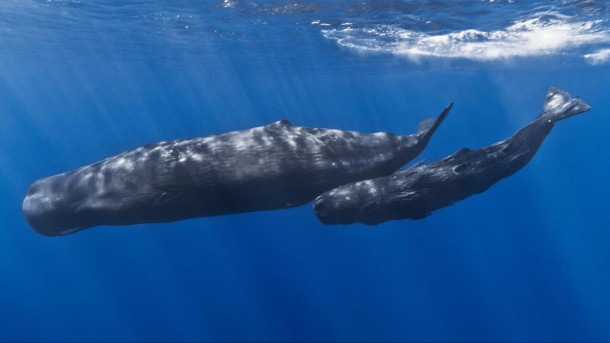
Picture above is a mother sperm whale and her calf off the coast of Mauritius. Deep diving whales use echo location to hunt prey. (Photo: Gabriel Barathieu, CC BY-SA 2.0)
DOERING: It’s Living on Earth, I’m Jenni Doering
O’NEILL: And I’m Aynsley O’Neill.
In a moment, an old road gets a new life as a park. But first this note on emerging science from Don Lyman.
[SCIENCE NOTE THEME]
LYMAN: Deep diving whales, such as sperm whales and beaked whales, use echolocation to hunt prey like squid in the darkness of the deep ocean, sometimes diving as deep as 3,000 meters, which is almost 10,000 feet. Unable to see at such depths, the whales emit sounds that bounce off objects and give the whales a picture of what’s around them.
But a new study from the Duke University Marine Lab in Beaufort, North Carolina, has found that when plastic debris in the ocean is hit by sound frequencies like the sounds whales emit, the echo is similar to common whale prey, like squid. And that may trick whales into eating the plastic.
Lead study author, Greg Merrill, and his colleagues, tested echoes from an assortment of plastic collected from the ocean — including plastic bags and bottles, rope, and other items that are often found in the stomachs of stranded whales.
The researchers also conducted acoustic tests on Atlantic brief squids, which are similar to the squid species deep-diving whales eat, as well as on squid beaks from a stranded sperm whale’s stomach.
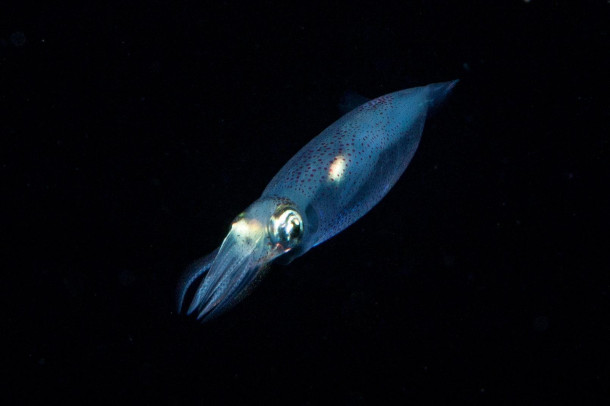
Duke University researchers found that when plastic debris in the ocean is hit by sound frequencies like the sounds whales emit, the echo is similar to common whale prey, like squid. (Photo: G.P. Schmahl, NOAA, Public Domain)
The team found that all the plastic items produced echoes as strong or even stronger than those of the whales’ prey items. “That was pretty striking,” Merrill says. This seems to suggest that “these animals have a hard time perceiving the difference between plastic and prey.”
This hypothesis is supported by deep-diving whales being found with a lot of plastic in them, more often than other species of whales, said Matthew Savoca, a Stanford University marine biologist who was not a part of the study. Savoca added that whales eating plastic can have deadly consequences for the marine mammals, because the plastic debris can fill the whales’ stomachs and intestines and prevent food from passing through their digestive tract.
That’s this week’s note on emerging science. I’m Don Lyman.
Related links:
- Duke Today | “Plastic Pollution Sounds Just Like Food to Deep-Diving Whales”
- Read the study “Acoustic signature of plastic marine debris mimics the prey items of deep-diving cetaceans”
[SCIENCE NOTE THEME]
Highway Reborn as Public Park

Sunset Dunes Park in San Francisco used to be a four-lane highway. (Photo: Jack Persons, Friends of Sunset Dunes)
DOERING: The four lane Great Highway used to run along the Pacific Ocean on the west side of San Francisco. But in April 2025, this pavement became a little slice of paradise. Now visitors to Sunset Dunes Park can bike, walk, skate, and play next to the water. Zach Lipton is a volunteer with the nonprofit Friends of Sunset Dunes and he joins us now to talk about this highway’s transformation. Welcome to Living on Earth, Zach!
LIPTON: Thank you so much. Glad to be here.
DOERING: So for someone who's maybe never been to San Francisco or to Sunset Dunes Park, what might they find at this park? You know, what is it like?
LIPTON: Sure, Sunset Dunes is a 50 acre park at the edge of San Francisco along the Pacific coast. It used to be a four lane highway and has been converted into a recreational space for people to walk and bike and sit by the ocean, have a bite to eat and just enjoy our Pacific coast. So we brought in eleven local artists to paint murals, five sculptures from around the Bay Area. The city has installed benches made out of logs that have fallen in recent storms from the park with natural log seeding, a bike park and a skate area down at slope, which has become popular. And of course, just the Pacific Ocean View is the star of the show.
DOERING: Yeah, and that wonderful ocean breeze. What about the sculptures? What are some of those things that kids can play around on?
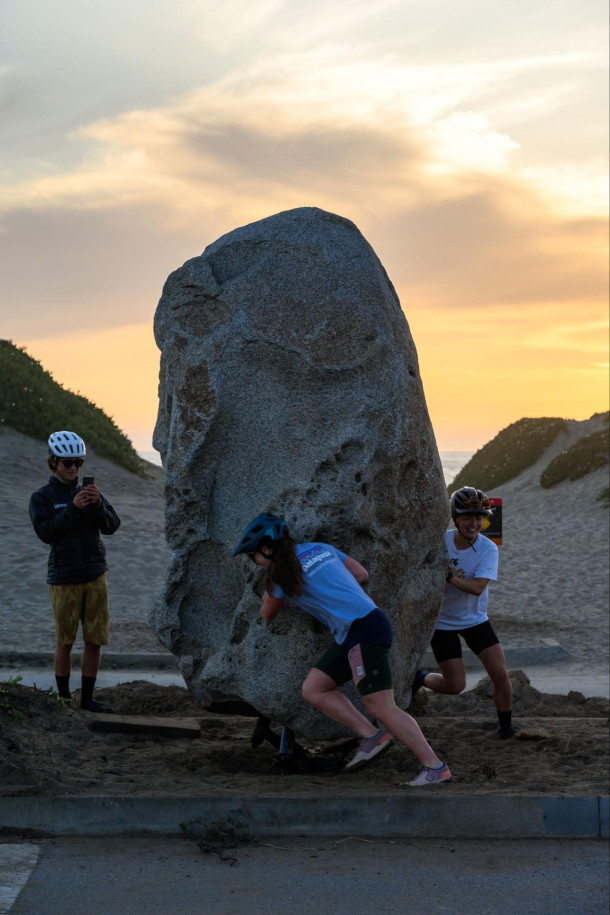
The “Spinning Rock” at Sunset Dunes Park. (Photo: Jack Persons, Friends of Sunset Dunes)
LIPTON: Sure. One of my favorites is a piece that, it's just called Spinning Rock. It's a 20,000 pound rock that is on a spinner. And just the look of delight when kids and adults, when everyone realizes you can just push this rock and start spinning it around. It's a lot of fun. We have a giant octopus the kids love to climb on, some giraffes down by the zoo. So it's been a lot of fun.
DOERING: And by the way, from the pictures that I've seen, it looks fairly flat. A lot of San Francisco famously has some very steep hills, but not so much for this park, huh?
LIPTON: Yes, it is a perfectly flat space, which is great for people, especially riding bikes. I know folks who have come out, learned to ride a bike there during the pandemic as an adult, using Sunset Dunes. And then, you know, they started off shaky and just kind of using it for recreation. And because of the confidence of that, started riding a bike for transportation all around the city. And so spaces like this, I think, are important to help people find alternative modes of transportation and get comfortable using them.
DOERING: So, you know, going from a four lane roadway to a coastal park, how exactly did we get here?
LIPTON: So let's go back all the way to just give you the long version of the history. The entire western side of San Francisco originally was just sand dunes, and in the 1800s some folks started creating a coastal path back when a road really was a recreational facility. This was a place to go ride your horse along the ocean. In time, that road was paved, but it always, for over a century, has been part of the city's Recreation and Parks Department, even though gradually, it kept shifting from a recreational use to really just transportation. Gradually it got widened to four lanes, and then during the pandemic, there was a huge need in San Francisco for socially distanced outdoor recreation, and the city converted a couple of streets to recreational facilities, including what was the Great Highway. And a lot of people really loved it, and just were coming out there for, for a daily walk, for a bike ride, and just to enjoy being there. And a group of friends and neighbors got together and started what was then called Friends of The Great Highway. We started putting on fun events like The Great Hauntway, which is an annual Halloween carnival for kids trick or treating along the road--

Kids and adults enjoy the octopus sculpture at Sunset Dunes Park. (Photo: Jack Persons, Friends of Sunset Dunes)
DOERING: Oh, cool.
LIPTON: --and other events, and ultimately organizing around what can we do to keep this space and preserve it? A few years ago, it was converted from full time park into part time. Cars would drive on it on weekdays, and people could use it on the weekends. And then ultimately, we ran a campaign, a ballot measure last November for the city to vote on its future. 55% of the city voted that they wanted it to be a full time park. And then we worked quickly with the city, with the California Coastal Commission, to make that vision a reality and start its transformation.
DOERING: Yeah, certainly the pandemic, it really kind of transformed the way that people thought about access to open space.
LIPTON: It really did. And I think there's a lesson there in that a lot of these things, you really have to try them in order for people to see the benefit of them. That we always like to say that the park sells itself more than we can ever explain its benefits to people. And this is something where if a few years ago, you said, yeah, let's turn the Great Highway into a park, people would look at you like you were crazy. But having tried it during the pandemic, and having just had the chance for people to experience it, all of a sudden, it makes a lot more sense. And I think there's a spirit of experimentation there that cities can embrace, whether it's this or other environmental efforts, that it's okay to just try things and see how they go.
DOERING: You know, one of the interesting aspects you mentioned is that this became a full time park by popular vote. How popular is the park now, and how in use is it?
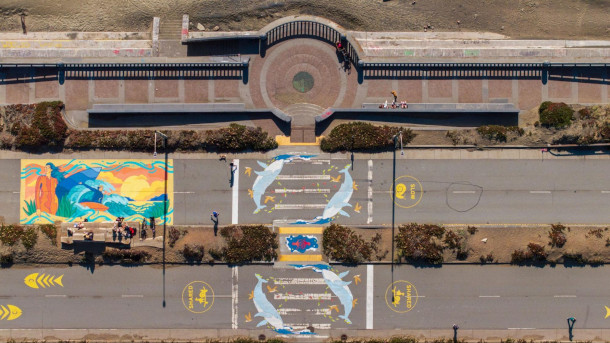
Eleven local artists have painted murals throughout Sunset Dunes. (Photo: Jack Persons, Friends of Sunset Dunes)
LIPTON: It's definitely very popular. It's become one of the city's most visited parks immediately, which is great to see. We're seeing over 10,000 visitors on the average weekend, we had 13,000 visitors come to our opening day in April. We have several thousand visitors every weekday coming and enjoying the park. At least for me, I think a lot of San Franciscans have, it's easy to take the ocean for granted here, and it's not a city that has been historically oriented along the coast, like a Santa Monica or Venice Beach or something like that. But we are so lucky to have the Pacific Ocean right here in our city, and it's really, I think, connected a lot of us more to the coast. And we're not just, you know, getting a quick glimpse of it as we drive by. We're really spending quality time there as well.
DOERING: Yeah, and by the way, how easy is it to get to the park?
LIPTON: Absolutely, there are two light rail lines that go directly to the park. A couple of our bus lines go there. It's connected to the city's bike network with a car-free path leading there. And of course, if you want to drive there, there's plentiful parking as well, so lots of options.
DOERING: Some of the neighborhoods just adjacent to the Great Highway, which is now Sunset Dunes Park, voted no on this ballot initiative at a rate of more than 80%. What are the concerns of people who are opposed to it?

A skate park in Sunset Dunes. (Photo: Jack Persons, Friends of Sunset Dunes)
LIPTON: I've heard a few things. I think there were definitely some concerns about traffic, but the studies before the park opened, and then the studies that we've seen since the park has opened have been incredibly consistent. What we've seen overall is a change of about one to four minutes at rush hour less at other times in terms of drive times north-south across the city since the park opened. And the trade off for that is, we get a wonderful coastal park. It's also something where the road, the Great Highway, there are three different parts to it, and the southernmost part of the Great Highway was set to close anyway, due to coastal erosion threatening the city's wastewater infrastructure. So because that was happening, traffic patterns were going to need to change no matter what. So it was really a question of, where are people going to make that left turn inland if they're driving south, and if we make that left turn a little earlier, we can enjoy this wonderful coastal park instead. So that was definitely one concern, though I think both studies from the San Francisco Chronicle and the city's own data have borne out that traffic has really been okay and been just as predicted. I think there's a broader issue where of just sort of a fear or reluctance of change people are used to, this is the way it's always been, and this is the way they'd like it, and that's, that can be hard to adapt to.
DOERING: Well, it sounds like, you know, as the coast changes and erodes, and you know, certain parts were going to be shut down anyway, like you said, this sounds like a great silver lining as part of adapting to this changing future.
LIPTON: Exactly, change is going to happen one way or another. The ocean is going to win in the end. That is, we can't fight the ocean. So in terms of coastal adaptation, sea level rise adaptation, this is really an opportunity to create a great public space to do what's right for the environment. And ultimately, you know, I think it started to win people, even its critics, over just being able to be there and see the space. Certainly not everyone, but the great thing about public spaces and parks is that they're for everyone to enjoy.

Visitors to Sunset Dunes Park enjoy a stroll along the Pacific coast. (Photo: Jack Persons, Friends of Sunset Dunes)
DOERING: So, you know, this park doesn't show up necessarily as a huge green swath on the map when you like, look at Google Maps or something like that. A lot of it is this roadway, but I understand there's also an ecological dimension to the park's transformation. How might Sunset Dunes Park contribute positively to the natural environment there?
LIPTON: There absolutely is. The sand dunes adjacent there have been neglected for a very long time, because when it's a roadway, the priority is preserving it as a roadway and pushing lots of sand around with bulldozers and invasive species all around it, invasive ice plant. So it's really not been treated as the environmentally sensitive area that it is. And the beach right adjacent there is home to the Western snowy plover, which is a federally endangered species. So this is a real opportunity to re-imagine that and do what's right for our coastal habitat. So we've started with the city and the National Park Service a dune restoration pilot where we had 100 volunteers transplanting native rye grass to introduce more native species to the area. That's been successful, and they're going to continue that effort during the planting season this fall. And it's also an area where this connects Golden Gate Park to Fort Funston and other natural areas south of there. So it's really about creating a green corridor all along the western edge of the city. Long-term, we're going to follow the science, and there are technical studies underway to analyze the effects of sea level rise on the area and to ultimately craft a plan for the dunes that will restore habitat and create a resilient coast that future generations can enjoy.
DOERING: So Zach, as someone who grew up in San Francisco, how are you hoping this park will transform the city and maybe influence its culture?

Zach Lipton is a volunteer with the Friends of Sunset Dunes nonprofit. (Photo: Drew McDaniel)
LIPTON: I think San Francisco has a bit of a tradition of doing things like this. The city tore down the Embarcadero freeway on our eastern edge of the city, and that's turned into a great waterfront promenade that is a popular tourist attraction. And I think that this is an opportunity to do something similar on the western side of the city, and really bring our city closer to the coast, and give people a reason to come out to the ocean and enjoy it and just have a better relationship with our Pacific Ocean.
DOERING: How do you think the story of Sunset Dunes creation could be a model for other cities looking to transform their spaces?
LIPTON: This is really something any city can do. It doesn't require years of study or millions of dollars in capital projects. You can just create public space like this and watch it evolve and see what happens. And so many of our cities have, you know, 99% of our streets or more are devoted to just the throughput of private car traffic from point A to point B. And really it's, you know, what if we shift that balance, even just 1%? All of a sudden, it opens up so many possibilities for transformation, and for the environment, for how we relate to public space and community space, to just be with each other. And I just want to stress that this is something that people in any city can do. You can get together with your friends and your neighbors and transform public space. And it really doesn't need to be an expensive, big public works project. This is something that anybody can take part in and make their city a better place together, and that's really been the most rewarding part of this, is just getting to work with everyone and making new friends and making the city a better place.
DOERING: Zach Lipton is a volunteer with the Friends of Sunset Dunes nonprofit in San Francisco. Thank you so much, Zach.
LIPTON: Thank you.
Related links:
- Read more about Friends of Sunset Dunes
- The San Francisco Chronicle | “Has the Great Highway Closure Led to a Traffic Nightmare? This Is the Most Complete Data Yet”
[MUSIC: Joni Mitchell, “Big Yellow Taxi” on Ladies of the Canyon, Warner Records Inc.]
O’NEILL: After the break, humanity is seeing the universe with new and much more powerful eyes. That’s just ahead on Living on Earth.
ANNOUNCER: Support for Living on Earth comes from the family of Rosamund Stone Zander - a celebrated painter, environmentalist, and author of The Art of Possibility – who urged us to protect life on this planet by finding possibilities and embracing opportunities. Support for Living on Earth also comes from Sailors for the Sea and Oceana. Helping boaters race clean, sail green and protect the seas they love. More information @sailorsforthesea.org.
[CUTAWAY MUSIC: Edgar Meyer, “ Cello Suite No. 1 in G Major, BWV 1007” On Bach Unaccompanied Cello Suites Performed on Double Bass, by Johann Sebastian Bach/arr. Edgar Meyer, Nonesuch Records]
An Extraordinary New Telescope
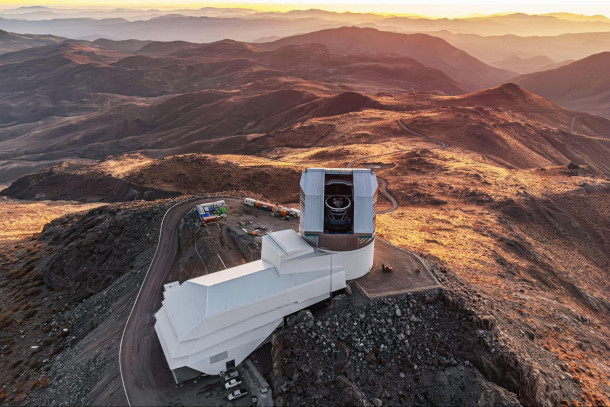
The Vera C. Rubin Observatory sits on the mountain ridge Cerro Pachón in Chile. (Photo: RubinObs/NOIRLab/SLAC/NSF/DOE/AURA)
DOERING: It’s Living on Earth, I’m Jenni Doering.
O’NEILL: And I’m Aynsley O’Neill.
Ever since Galileo began to study the heavens, telescopes have provided a window into the wonders of our universe, from supernovae to distant galaxies. And in recent years, innovations like the James Webb Space Telescope have produced images of those wonders with more depth and detail than ever before. Now astronomers are looking forward to yet another leap in their field. Later this year, the new Vera C. Rubin observatory telescope will start photographing the entire southern sky repeatedly for a full decade, looking for changes in the universe. Here to tell us more about what this could mean for science is Clare Higgs, an astronomer on the Rubin Education and Public Outreach team. Welcome to Living on Earth, Clare!
HIGGS: It's great to be here.
O'NEILL: So what is the Vera C. Rubin observatory, and what kind of data will the new telescope there be collecting?
HIGGS: The Vera C. Rubin observatory is a brand new observatory that is just completing construction and getting close to starting its operations. It's located down in Chile, high up on a ridge called Cerro Pachón. And this observatory is, it's amazing. It's so exciting. It is essentially going to create the greatest cosmic movie ever made that's how I like to think about it. We are creating a survey, so repeatedly scanning the southern sky for a decade, and so we're going to create this enormous data set that is going to be interesting on so many fronts for so many different areas of astronomy.
O'NEILL: And I mean, there are lots of cool telescopes in the world, but this new one is, as far as I can tell, unlike any we've had before. So tell us what makes it so groundbreaking.
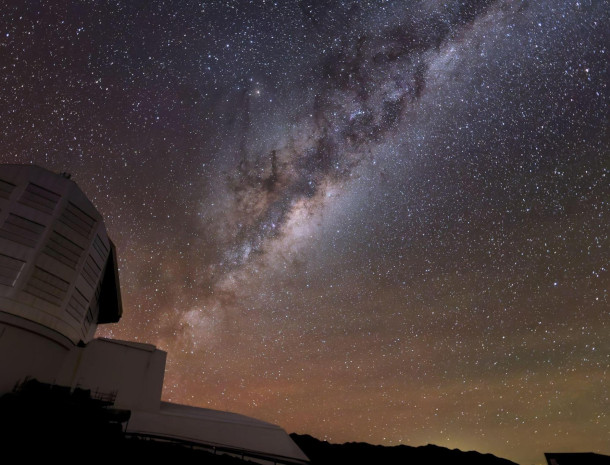
Starting later in 2025, Rubin Observatory's decade-long Legacy Survey of Space and Time (LSST) will generate an ultra-wide, ultra-high-definition, time-lapse record of the Universe. (Photo: RubinObs/NOIRLab/SLAC/DOE/NSF/AURA/W. O'Mullane)
HIGGS: Yeah, so the Rubin Observatory is a survey telescope, which is not new. There have been other survey telescopes before, but the size of this telescope, the size of our camera, and the way we're scanning the sky, and the depth and the cadence, how quickly we're scanning the sky, is all new. So we have the largest camera ever built. It's about the size of a small car, so it's huge.
O'NEILL: Wow!
HIGGS: Yeah, and it's a 3200 megapixel camera. It's enormous. I'm not particularly tall. I'm about five foot two, but the lenses are almost exactly my height in diameter. So these are absolutely enormous lenses on the front of the camera, and we take an image about every 40 seconds, and we do that all night, every night, for 10 years. So that volume of data is enormous, and it's a very sensitive camera, and we take these very large images, so they are about 10 square degrees on the sky. To give you a visual of what that is, about 45 full moons would fit inside each image. So there are enormous pictures we take, lots of them with this huge camera, and doing that really quickly allows us to create this amazing survey.
O'NEILL: And so when you say these pictures are taken every 40 seconds, will the survey just essentially be almost like a massive time lapse?
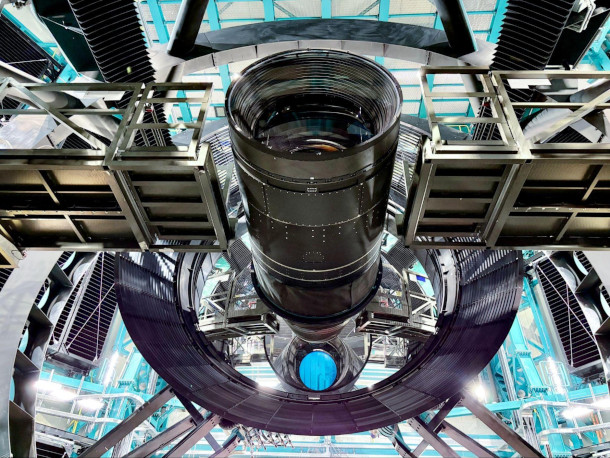
The Vera C Rubin observatory’s telescope uses the world’s largest digital camera. The lens is just over five feet across. (Photo: RubinObs/NSF/DOE/NOIRLab/SLAC/AURA/T. Lange)
HIGGS: Yeah. So there's a couple things that come out of this survey, and that's one of the things I'm really most excited about, is the fact that there are many ways you can use this data. Depending on what science questions you're interested in, and you want to study, you can look at this data in many ways. So yes, you could use this data as a giant time lapse. One of the other things we do is essentially add all these images together, and when you add the images together, stack them together, you can see very deep and so you can see very faint sources as well. So you could either look at it as a time lapse and see things that vary and change and move in the night sky. So things like supernova and asteroids, you can detect those, or you can stack them together and see distant galaxies and distant galaxy groups in the faint universe. And those distant objects can tell us about the history of the universe, because essentially, telescopes are time machines. When you look far away, you're actually looking back in time, because light takes time to get to our observatory. And so studying that distance universe is studying that ancient universe, which is really fascinating.
O'NEILL: And now the survey that you've mentioned is going to take place over 10 years. It sounds like the telescope will be collecting just a massive amount of data. It's kind of even hard to fathom. So how can we conceptualize just how much data we're talking about here?
HIGGS: Yeah, so every night, Rubin produces about 20 terabytes of data, which means that the survey in total, is hundreds of petabytes of data. So it's an enormous amount of data.
O'NEILL: You said petabytes. And I went, I haven't even heard that prefix before.
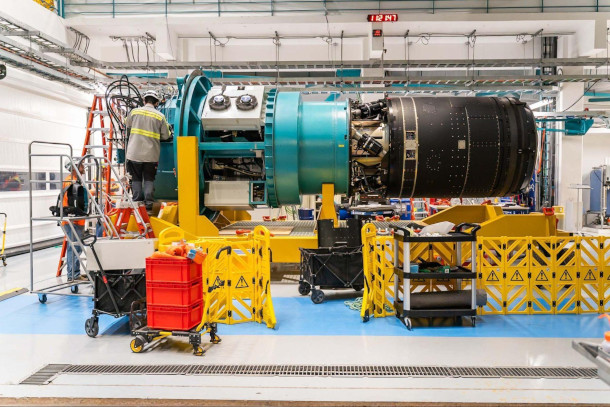
NSF–DOE Vera C. Rubin Observatory and SLAC National Accelerator Laboratory team members prepare the LSST Camera — the world’s largest digital camera — for its move to the eighth level, where it will be installed on the Simonyi Survey Telescope. March 2025. (Photo: RubinObs/NOIRLab/SLAC/NSF/DOE/AURA/A. Pizarro D.)
HIGGS: Mmmhmm, exactly. So a petabyte is 1000 terabytes. So it's one level larger when we think of the scale of data. And one way to think about how much data that is, is if you watch the entire Lord of the Rings extended 4k movie series continuously for three weeks, that's 20 terabytes of data. So Rubin does that every single night.
O'NEILL: Oh wow, every night! Really dedicated Lord of the Rings fans here.
HIGGS: Exactly, exactly. And then one other way to understand the data that is being produced. So alerts are basically produced in almost real time. So they're sent out within minutes of an observation being taken, and they track changes in the night sky, so think about things that flash, move or blink. And those alerts, Rubin is expected to produce up to about 10 million of those each night.
O'NEILL: Wow.
HIGGS: So it's a lot of data.
O'NEILL: I know there's so much that we can be expecting to learn here, but let's talk about a few of the specific things you know. What are the astronomers and scientists you've talked to most excited about here?
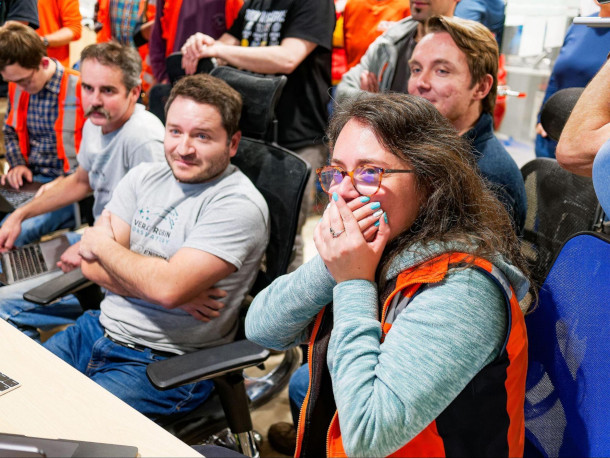
The Rubin team in the control room on Cerro Pachón reacts to seeing the first on-sky engineering data captured with the LSST Camera on April 15, 2025. (Photo: RubinObs/NOIRLab/SLAC/DOE/NSF/AU)
HIGGS: If you ask that question to 100 Scientists, I think you would get 100 different answers. So it's a great question, but some of the broad science themes that we talk about for Rubin are exploring dark matter and dark energy, mapping our own galaxy, the Milky Way, doing a census of our solar system, and exploring that dynamic sky, the changing sky, looking at these things. So that's kind of four broad science areas. One little example that I will highlight that came up in the last couple months is, I don't know if you heard about the new interstellar object that was observed. This is the third such object that we as humanity have ever observed. And these are objects that come from solar systems, other than our own, small objects that are, you know, invisible to any observatory because they'd be usually too far away. There was a new one observed in July of this year. And so that brings our grand total to three. Rubin is an amazing observatory for finding and detecting these kind of objects. And so hopefully we'll go from a group of three of these objects to maybe 10, maybe 20, maybe 50. And having a sample of these objects allows us to create a much more complete picture of what kind of objects these are, where they're coming from, and start asking, you know, questions about other solar systems.
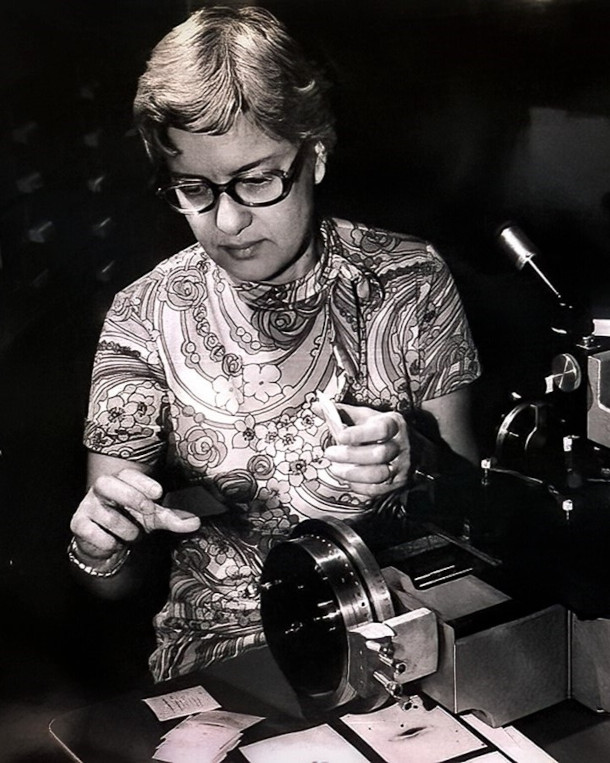
Vera Rubin was an American astronomer whose work made major strides in the study of galaxy rotation rates. (Photo: NOIRLab/NSF/AURA, Wikimedia Commons, CC BY 4.0)
O'NEILL: So just briefly explain for us what dark energy or dark matter is. How would the survey help us learn about these things?
HIGGS: So dark energy and dark matter are two elements of our universe, and this was actually part of Vera C. Rubin, the astronomer for whom our telescope is named after, part of her research was on dark matter. So dark matter is essentially a mysterious form of matter which holds structures in our universe together. So Vera Rubin's research, she was looking at spiral galaxies, and she noticed how fast they were rotating, and essentially she looked at how fast they were rotating, and then how much baryonic matter. So stuff that you can see, this is like you and I, gas, dust, stars. She looked at the baryonic matter, and she saw how fast they were rotating, and she said, "Hang on a second. There must be something else here." And so that was really the first compelling evidence for dark matter. Dark energy, on the other hand, is essentially it's a force that is causing our universe to expand. So you may have heard of the factor universe expanding, but it's not only expanding, it's accelerating in this expansion. So dark energy is is part of the driving force behind that. One of the ways that Rubin Observatory can help us understand dark matter is by using something called weak lensing. And so this is a phenomenon where, as light from galaxies travels through our universe, the presence of dark matter will cause distortions in their shapes. And if you can measure the shape of a lot of galaxies, and a lot, you know, hopefully you're talking millions, tens of millions. Rubin will look at 20 billion galaxies. So that's a lot of galaxies. That's what we need. You can map the structure of these distortions, which allows you to understand the matter that it has passed through, which gives you an insight into the dark matter structure of our universe.
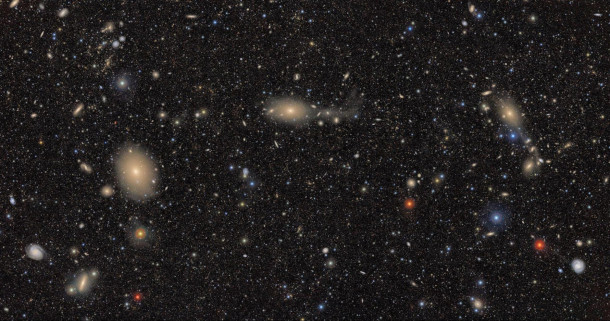
One of the Vera C. Rubin observatory’s “First Look” images from June 2025: the Virgo Cluster. (Photo: NSF–DOE, Vera C. Rubin Observatory)
O'NEILL: And now I know that a number of images have been released so far, I think, from June of this year. So can you describe a few of those to me? You know, ones that really stood out to you?
HIGGS: Yeah, so in June of this year, we released our first look images that we took early in commissioning, and we're really excited to share with the world, as it's the first glimpse of what Rubin can do, and then the kind of the amazing imagery that is to come once the survey starts. My personal favorite image is our cosmic treasure chest image. And so this is a image of the southern part of the Virgo cluster. So this is a nearby galaxy cluster. And this image was comprised of over 1100 exposures, so it's about three and a half trillion pixels worth of data, and it was taken in just over 10 hours of observations to compile this absolutely enormous image. So I absolutely love this image, because I feel like it really demonstrates the fact that Rubin is going to revolutionize many different areas of science, because in this one image, you can see things at many different distances and many different types of structures. So if you look at the image, probably the first thing that would catch your eye are these large galaxies, think big elliptical galaxies and spiral galaxies, and these are all part of the Virgo cluster, so this is kind of our nearby universe. Behind that is an absolute sea of, kind of red blobs, and those red blobs are all galaxies at larger distances, well beyond the Virgo cluster. Also in this image, you can see stars from our own galaxies. And then one thing that's really cool that we did is usually when you create an image like this, where you take a lot of exposures and you stack them together, you lose everything that moves. So you'd lose all the asteroids, but we actually added them back in. We have an app to explore this image called Skyviewer. And in Skyviewer, you can turn the asteroids back on, and you can see these tracks of all these moving objects. And so that's our solar system. So in this one image, you have the asteroids in our solar system, the stars in our Milky Way, the galaxies in Virgo in our local universe, and then the distant universe behind as a sea of red distant galaxies. And it's just this huge swath of science in one image.
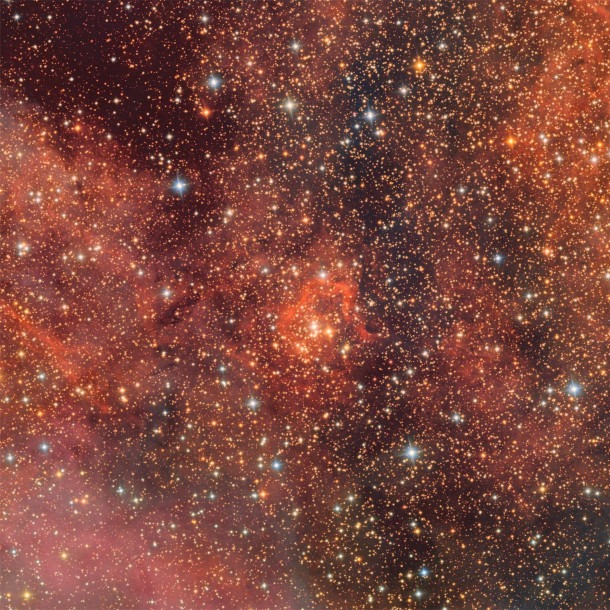
The open star cluster Bochum 14 as imaged by NSF–DOE Vera C. Rubin Observatory, part of the “First Look” images from June 2025. (Photo: RubinObs/NOIRLab/SLAC/NSF/DOE/AURA)
O'NEILL: Now, from what I understand, this image was not shared just visually, but I believe there was some sort of audio component as well, and we on the radio are always keen to hear about that.
HIGGS: Yes. So this is one of the things that I am so thrilled about, is we released a sonification of this image. And so what this sonification is is a audio representation of the data. So really importantly, it is driven by the data. It's driven by the pixels. And again, you can explore it in our sky viewer, essentially, you can cruise around the image, and as you cruise around the image, you're hearing two things. The color of the pixels you're cruising over will be played, and also the objects as you pass them will be played. The way it works is that redder light and longer wavelengths goes to lower pitches, where bluer light or shorter wavelengths goes to higher pitches, and the volume maps to brightness. And when you pass over objects, galaxies are harp sounds and stars are glockenspiel or time sounds. And so you can explore this image through sound.
O'NEILL: And now the survey hasn't started yet, but once it's up and running, how will the data from it be shared? You know, what's the timeline from the start of the survey to the first data released? And to what extent will the public be able to interact with it?
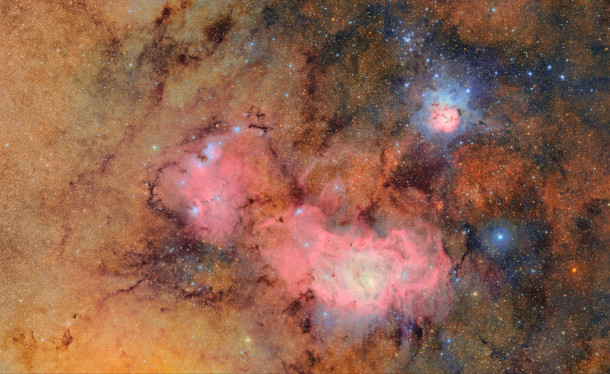
This image combines 678 separate images taken by NSF–DOE Vera C. Rubin Observatory in just over seven hours of observing time. Combining many images in this way clearly reveals otherwise faint or invisible details, such as the clouds of gas and dust that comprise the Trifid nebula (top) and the Lagoon nebula, which are several thousand light-years away from Earth. More information about this image is available on RubinObservatory.org. (Photo: NSF–DOE Vera C. Rubin Observatory)
HIGGS: So the LSST survey should start toward the end of this year, early next year, and there'll be a period of data collecting, and then there will be these data releases. And these data releases will be a compilation of the year or so of data taken before that, which will be shared to the astronomy community. There are some aspects of the data that is collected that will be shared faster and more broadly. So these alerts, those are publicly accessible, and those will be shared on the order of minutes. One way that the public can enjoy and participate in the science coming from Rubin is through citizen science projects. And so we are partnered with The Zooniverse, which is a amazing citizen science platform, and on there, astronomers from the science community will share specific sets of data with a specific science question, and the public is welcome and encouraged and invited to participate in helping to classify that data, which will help inform the science that we can do and be part of the discovery process. And just to give you a sense of scale, Rubin is expected to observe about 20 billion galaxies and a similar number of stars. And you know, the volume of data we've talked about, it's far too much data for one person to look at. And so having these citizen science projects is really a key part of of some of the science that will come out of Rubin.
O'NEILL: Clare, on a personal level, what are you most excited about as we look forward to this survey getting off the ground?
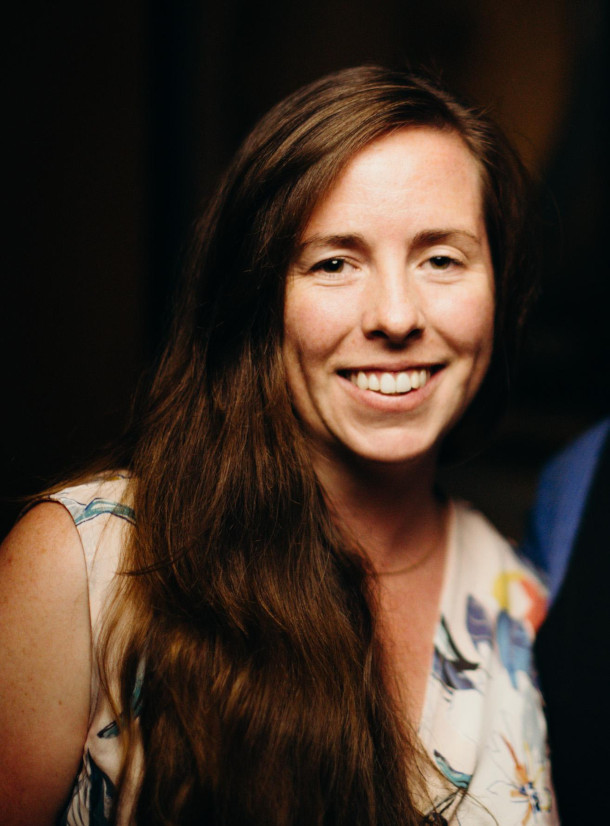
Clare Higgs is an astronomer and a member of the Education and Public Outreach Team for the Vera C. Rubin Observatory. (Photo: Courtesy of Clare Higgs)
HIGGS: That's a really tough question. There's so many things that are exciting and that I can't wait to see. So my research, personal research area, is looking at dwarf galaxies, and I'm really excited to see how Rubin can find a more complete census, a more complete understanding of these really small galaxies. So personally, I'm quite interested in that, but I think that more broadly, there's two things. One is, I'm excited to see what comes from this community of scientists. Rubin has an amazing community, both based in the United States and Chile, as well as international partners who are so ready to make the most of this data set and this amazing observatory, and so seeing what comes out of this community is I just can't wait. And also, as a slightly mysterious answer, the other thing that I'm really excited about is the unknown unknowns, the things that we don't even know are out there. We don't even know to look for that are going to come out of this data set. We have seen through time with every time there's a new observatory, new technology, that when you look at the sky in a new way, you discover something new and unexpected. And Rubin is looking at the sky in a new way. We're opening up the time domain. We're looking at this changing, dynamic sky. We're making this time lapse of the southern sky, and so who knows what we'll see. I just can't wait to find out what that is.
O'NEILL: Dr. Clare Higgs is an astronomer and a member of the education and public outreach team for the Vera C. Rubin Observatory. Clare, thank you so much for giving us your time today.
HIGGS: It was an absolute pleasure, and I'm so excited to share the Rubin Observatory with you.
O’NEILL: And we’ll let you hear a little more of that data sonification. This is from the “cosmic treasure chest” image that Clare Higgs mentioned, of the Virgo galaxy cluster and objects far beyond.
Related links:
- Learn more about the Vera C. Rubin observatory
- Look at or listen to Rubin’s “First Look” Images with the Skyviewer App
- Browse images from the observatory
[Virgo Galaxy Cluster Sounds]
DOERING: Next time on Living on Earth, Fat Bear Week is back!
JIMENEZ: In Katmai National Park, it's the sockeye salmon. They're really the unsung heroes of the competition. Without that strong sockeye salmon run, we wouldn't have Fat Bear Week. The timing of the bears showing up at the Brooks River coincides with that salmon run and July is when the run starts. And so we'll see a lot of the bears concentrate in the Brooks Falls area, because that's where the salmon are swimming upstream to spawn. And then we'll see the bears concentrate once again, in the lower portion of the river in September, when the salmon have spawned out, they're dying. So they're washing up on the shores of the river, and then the bears can just pick them off. So it's mostly those two months when we see our highest concentrations of bears. That's what's supporting the weight gain of the bears during the summertime.
DOERING: Vote for the bulkiest brown bears and tune in next week to hear all about the winner.
[MUSIC: Michael Pitluk, “Upbeat Folk (Instrumental)” Single, Michael Pitluk]
O’NEILL: Living on Earth is produced by the World Media Foundation.
Our crew includes Naomi Arenberg, Paloma Beltran, Sophie Bokor, Daniela Faree-ah, Swayam Gagneja, Mark Kausch, Mark Seth Lender, Don Lyman, Ashanti Mclean, Nana Mohammed, Sophia Pandelidis, Jade Poli, Jake Rego, Andrew Skerritt, Bella Smith, Melba Torres, and El Wilson.
DOERING: Tom Tiger engineered our show. Alison Lirish Dean composed our themes. You can hear us anytime at L-O-E dot org, Apple Podcasts and YouTube Music, and like us please, on our Facebook page, Living on Earth. Find us on Instagram at Living on Earth radio, and we always welcome your feedback at comments at loe.org. Steve Curwood is our Executive Producer. I’m Jenni Doering.
O’NEILL: And I’m Aynsley O’Neill. Thanks for listening!
ANNOUNCER: Funding for Living on Earth comes from you, our listeners, and from the University of Massachusetts, Boston, in association with its School for the Environment, developing the next generation of environmental leaders. And from the Grantham Foundation for the protection of the environment, supporting strategic communications and collaboration in solving the world’s most pressing environmental problems.
ANNOUNCER 2: PRX.
Living on Earth wants to hear from you!
Living on Earth
62 Calef Highway, Suite 212
Lee, NH 03861
Telephone: 617-287-4121
E-mail: comments@loe.org
Newsletter [Click here]
Donate to Living on Earth!
Living on Earth is an independent media program and relies entirely on contributions from listeners and institutions supporting public service. Please donate now to preserve an independent environmental voice.
NewsletterLiving on Earth offers a weekly delivery of the show's rundown to your mailbox. Sign up for our newsletter today!
 Sailors For The Sea: Be the change you want to sea.
Sailors For The Sea: Be the change you want to sea.
 The Grantham Foundation for the Protection of the Environment: Committed to protecting and improving the health of the global environment.
The Grantham Foundation for the Protection of the Environment: Committed to protecting and improving the health of the global environment.
 Contribute to Living on Earth and receive, as our gift to you, an archival print of one of Mark Seth Lender's extraordinary wildlife photographs. Follow the link to see Mark's current collection of photographs.
Contribute to Living on Earth and receive, as our gift to you, an archival print of one of Mark Seth Lender's extraordinary wildlife photographs. Follow the link to see Mark's current collection of photographs.
 Buy a signed copy of Mark Seth Lender's book Smeagull the Seagull & support Living on Earth
Buy a signed copy of Mark Seth Lender's book Smeagull the Seagull & support Living on Earth

